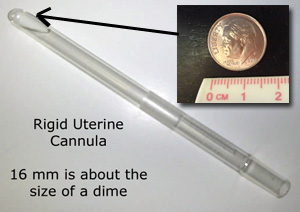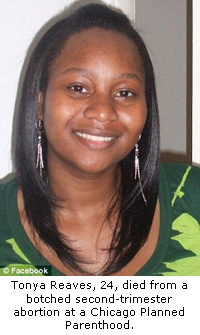An Operation Rescue In Depth Analysis
By Cheryl Sullenger
Chicago, IL – With the assistance of the Thomas More Society, Operation Rescue has obtained a copy of the sworn deposition of Planned Parenthood abortionist Mandy Gittler, who was responsible for inflicting a fatal second trimester abortion on Tonya Reaves on July 20, 2012. Gittler’s deposition gives horrific new insight into Planned Parenthood’s abortion practices and events that led to Reaves’ avoidable death.
It also reveals that her testimony was inconsistent with the conclusion of the Medical Examiner, the nurse’s observations recorded in the patient medical record, and with an early news report that relied on medical documents provided to a reporter by a confidential source.
Gittler’s 165-page statement was taken under oath on August 22, 2013, as part of the discovery process in a civil suit filed against Planned Parenthood on behalf of Reaves’ young son, Alvin.
Her inconsistent, evasive statements, defensive tone, and remarkable lapse of memory as recorded in the deposition may have contributed to Planned Parenthood’s agreement to pay out $2 million in compensation for Reaves’ death. That settlement agreement stipulates that attorneys will received over a half million in fees and expenses, leaving the just under $1.5 million to be paid out in a structured settlement to Alvin when he reaches the age of 18.
15,000 abortions
Gittler is a single mother of two children who is the sole owner of All Women’s Health Clinic in Chicago where she has just three employees. She said that she splits her time almost equally between that clinic, Planned Parenthood in Chicago, and National Healthcare, an abortion clinic in Peoria, Illinois.
Gittler admitted that sixty to seventy-five percent of her “practice” consists of abortions. However, Gittler is not a certified Ob/Gyn. Instead her specialty is “family medicine.”
“I consider myself more knowledgeable than most family medicine and/or obstetric physicians in abortion care,” she boasted.
After graduating from Rush Medical College in 1998, Gittler claims to have done 15,000 abortions in her career. She indicated that about 12,000 of those abortions were done in the first trimester, between 1,000 and 2,000 abortions were 14-15 week procedures, and 200-250 were abortions done at 15-16 weeks. She noted that only about 40-50 of the procedures done over her 11-year career were completed at 16 weeks. Gittler said that she has never done an abortion in the third trimester of pregnancy.
In fact, Gittler said that she does not do abortions after 16 weeks due to “my own comfort and skill set.”
“The fact that Gittler has a 16-week cut-off point for abortions is crucial information since Tonya Reaves was 16 weeks pregnant at the time of her abortion. That’s a gestational stage for which Gittler is least experienced and least comfortable,” said Troy Newman, President of Operation Rescue.
Complications rate?
Of the 15,000 abortions done by Gittler, she told attorneys during her deposition that she could only remember two complications: a case of “persistent bleeding” and a case where she could not “dilate the cervix,” which is necessary before abortion instruments can be introduced into the womb.
“This might have been a case of whitewashing the facts on Gittler’s part. Using very conservative complication rate estimates used by the abortion industry, Gittler could have experienced at least 375 abortion complications during her career. But she is under deposition in a very serious lawsuit that could cost her and Planned Parenthood a lot of money. I’m surprised she admitted to any complications at all,” said Newman. “Throughout the deposition, she attempts to evade questions that might present herself in a negative light.”
Further evidence of her selective memory was exhibited in her response to a question about her hospital privileges.
Q. Have you ever applied for privileges at any hospital and been denied?
A. Not that I recall.
Reaves’ abortion begins
Gittler’s deposition sheds light on Reaves’ final day of life, which began when she reported to a Planned Parenthood office located at 18 South Michigan in Chicago, Illinois, on the morning of July 20, 2012.
While the autopsy report confirms the South Michigan location, there is some concern that Reaves’ abortion did not take place there because there is no indication that surgical abortions are done at that location. In any case, the address of the Planned Parenthood facility where Reaves had her abortion is not mentioned in her deposition.
However, the cost of Reaves’ second trimester abortion was mentioned in the deposition. She was charged just $459 for a procedure that often costs upwards of $1,000. It is possible that the rest of Reaves’ abortion fee was subsidized by an abortion fund.
A news report based on a confidential hospital source filed by Steve Miller of News Radio WBBM and the First Call Sheet included with Reaves’ autopsy report both indicate that her 16-week Dilation and Extraction abortion began at 11:00 a.m. However, Gittler testified that she did not begin Reaves’ abortion until 12:51 p.m. This represents a large discrepancy in the time-line of events that lead to Reaves’ death.
Gittler said that she hardly spoke to Reaves prior to the abortion, except to ask four questions that she asks of every patient related to their confidence in their decision to abort. She indicated that she could not remember Reaves’ responses, but that they were, in her words, “Nothing out of the ordinary.”
Procedure 1
Reaves was first sedated for her 16 week Dilation and Evacuation abortion. Gittler inserted the speculum, which opened the birth canal so she could see the cervix, which is the neck of the womb. She pulled the cervix down with scissor-life grasping instrument called a tenaculum then injected the cervix with an anesthetic. She then began inserting dilators into the opening of the cervix in order to make it big enough to accommodate the 16 mm rigid cannula, which is a clear plastic tube attached to a suction machine.
Gittler then inserted the 16 mm rigid cannula and began to suction. At some point, ring forceps were used to grasp and remove parts of the baby.
It was 1:04 pm when Gittler finished, removed the speculum, and rectally administered 800 micrograms of Misoprostol, also known as Cytotec, a drug that causes the uterus to contract and seal off blood vessels for minimal bleeding.
Blood on the chuck
Gittler had just begun to fill out her paperwork when she noticed blood dripping onto the blue chuck pad underneath Reaves. It was enough blood that Gittler began to investigate. First she abdominally massaged Reaves’ fundus, or the top of the uterus, and noticed that instead of being firm, it felt “boggy,” a condition known as “atony.” This caused her to do a bi-manual uterine massage in order to help the uterus begin to contract.
Procedure 2
With the uterus still atonic, or “boggy,” Gittler conducted a second aspiration of Reaves’ uterus using a 7 mm flexible cannula with which she said she removed “less than a teaspoon” of blood. That procedure took about four minutes.
Reaves’ medical records show that she left the procedure room at 1:07 p.m. and taken to recovery while Gittler continued doing abortions on an unknown number of other patients.
Soaked Pad
At 1:41 p.m., just over a half hour from when Reaves’ second aspiration was completed, the nurse noticed that her sanitary “pad was soaked,” indicating that Reaves was experiencing “excessive bleeding.”
At 2:00 p.m., the nurse noted that Reaves was passing a blood clot. She notified Gittler, who at some point evaluated Reaves.
Implausible two-chambered uterus theory
Fifty-five minutes later, at 2:55 p.m., Reaves was back in the procedure room.
At 3:02 p.m., anesthesia was administered, an ultrasound exam was done. Gittler said she was confused by what she saw on the ultrasound, which to her appeared to be a mass next to the uterus. She concluded somehow that she could be looking at a bicornuate (two-chambered) uterus, an unusual deformity that she opined might have accounted for Reaves’ abnormal bleeding.
It was more likely that the second mass was instead blood accumulating in Reaves’ abdominal cavity due what was later confirmed to be a uterine perforation. The fact that Reaves had an uncomplicated abortion in 2010 made Gittler’s two-chambered-uterus theory implausible. Gittler admitted that she never reviewed the medical record from Reaves previous abortion at Planned Parenthood, even though it was available to her and could have shared light on what Gittler referred to as Reaves confusing anatomy.
Blaming the woman
Why did Gittler favor the idea that Reaves had a deformed uterus over the more probable explanation that she had ruptured Tonya’s uterus?
“Abortionists commonly try to make complications appear to be the fault of the woman who had the abortion. It always has to be her fault. Grasping onto the deformed uterus theory put the blame on Reaves whereas a uterine perforation would put the blame on the abortionist. This is all about shifting the blame,” said Newman.
Procedure 3
Using ultrasound guidance for the first time on Reaves, Gittler suctioned the uterus again using a 7mm flexible cannula. A 20 cc clot was removed, which is a little larger in size than a tablespoon. This procedure represented Reaves’ third abortion that day at Planned Parenthood.
Gittler said that she has changed her practice and now does all second trimester abortions with ultrasound guidance, at the advice of her attorney.
Ten minutes later, 10 units of Pitocin was administered to Reaves through her IV. Pitocin is a drug that is used in hospitals to induce labor. Gittler presumably used it to help Reaves’ uterus to contract. Three minutes after that, Reaves was given a shot of Methergine, a drug that is used to control or prevent post-partum hemorrhage.
At 3:35 p.m., the nurse noted in Reaves’ chart that the bleeding had slowed, but not stopped, and her uterus remained tender.
By 3:53 p.m., the nurse noted on Reaves’ chart that her bleeding continued to be heavy. Gittler disagreed and insisted that the bleeding was light. At that time, Reaves was administered Toradol, an NSAID pain reliever used to manage moderately severe acute pain.
Decision to transport
Gittler said she spoke with Tonya and her mother and told them she wanted to transport Tonya to the hospital. She said that Tonya told her that she felt fine and did not want to go.
According to Gittler, she then contacted her medical director, Carolyn Hoke, who told her that if Reaves’ bleeding was under control, there was no need to transport her.
Portraying herself as the hero of the story, Gittler testified that she ordered someone to call an ambulance “sometime before”4:00 p.m., supposedly over the objections of Reaves and her supervisor.
A note in Reaves’ chart indicated that 911 was called and that a Chicago Fire Department ambulance responded, but Gittler indicated that the ambulance may not have been a CFD vehicle.
Documents obtained by Operation Rescue indicate that 911 was not called despite a non-medical incident at that clinic earlier in the day when an employee was instructed by a 911 dispatcher that the fastest way to get help was to call 911 instead of the 311 non-emergency number, as had been Planned Parenthood’s practice.
“Giggling” with her mom?
At 4:17 p.m. the ambulance arrived. Gittler related the following story:
When Tonya was being transferred in the ambulance chair, so she was up and alert sitting in the — they — instead of a gurney, they have the gurneys that sit up. She was with Ms. Joyce, [Reaves’ mother] and she was kind of giggling that she didn’t want to go and who would watch the car.
“Women suffering from hemorrhage are often transported in a sitting position. This is to minimize bleeding. Yet Gittler relates this as if it means that Tonya was doing great and didn’t need to lay down,” said Newman. “It’s hard to imagine that Tonya would have been giggling with her mother about not wanting to go to the hospital. That comment seemed to be a strangely inappropriate attempt to make it appear that Reaves was in good condition and spirits when she left Planned Parenthood, when it is now obvious that her condition was actually life-threatening.”
Monitoring vs. emergency
In a critically important move, Gittler contacted an emergency room resident and noted that Reaves suffered from a “boggy uterus” with post-procedure bleeding that had subsided after re-aspiration. She noted that Reaves’ uterus was then “clamping down fine,” and she was being transported for further monitoring because of confusion about the patient’s anatomy.
Gittler downplayed the seriousness Reaves condition and never mentioned the possibility of a uterine perforation to the hospital resident, even though she admitted that she was aware that uterine perforation was a possibility.
Given that information, emergency room personnel had no reason to believe that Reaves’ condition was serious, much less life-threatening.
The transcript is clear about Gittler’s awareness that she may have perforated Reaves’ uterus:
Q. Prior to the third procedure on July 20th, you couldn’t rule out a uterine perforation in Ms. Reaves. Correct?
A. I couldn’t rule it out? I couldn’t rule it out.
Q. Okay. And even up until the time Ms. Reaves left Planned Parenthood on July 20th, you couldn’t rule out the fact that she had a perforated uterus. Correct?
A. I couldn’t rule it out.
Steve Miller’s news report indicated that Reaves was transported to Northwestern Memorial Hospital at 4:30 p.m.
Meanwhile, Gittler continued to do at least two more abortions after Reaves left Planned Parenthood by ambulance.
At the hospital
Once at the hospital emergency room, it took time for the doctors there to understand the full nature of Reaves’ condition.
In an attempt to control her heavy bleeding that Gittler insisted had “subsided,” Reaves was given her fourth abortion of the day at 5:30 p.m. where retained “products of conception” were removed.
Gittler called the hospital at 7:30 that evening and spoke with an Ob/Gyn intern who told her Reaves had just gotten out of the operating room where an aspiration had removed “placental tissue.”
“It’s appalling to hear that Reaves still had tissue inside her after three previous suction procedures,” said Newman. “While an incomplete abortion can cause a patient to hemorrhage, the records are clear that Tonya continued to deteriorate even after all the tissue was removed. This was an indication that something else was seriously wrong.”
Uterine perforation discovered
Reaves then underwent a series of tests that finally uncovered the source of her problems: a uterine perforation in two places that involved the left board ligament with a possible transection of the left uterine artery. Reaves had been bleeding internally for between nine and eleven hours, depending on when her first abortion began.
At 10:12 p.m., Reaves was rushed back in to the operating room for an emergency hysterectomy, but she coded during the procedure and the surgeons were unable to resuscitate her. She was pronounced dead at 11:20 p.m. while still in the operating room.
According to the autopsy, her abdomen was filled with 1.5 liters of blood and clots. The human body holds roughly five liters of blood. Reaves bled about 30 percent of her total volume of blood into her abdomen, and that does not account for the amount of blood lost through what was likely substantial vaginal bleeding due to the retained tissue.
Planned Parenthood informed of Reaves’ death
The following day, Gittler was called by Planned Parenthood’s medical director, Carolyn Hoke in the evening and informed that Tonya Reaves had died. Hoke said she learned about it from a reporter and at first was confused about which patient the reporter meant.
Gittler told Hoke that when she had called the hospital at 7:30 p.m. the previous evening, Reaves was stable. She asked Hoke when Reaves died. Hoke, who seemed to have scant information, indicated that she believed Reaves passed between 11:00 p.m. and 12:00 a.m.
Autopsy results
Gittler denied that she ever read Reaves’ autopsy report and remained evasive about any knowledge of injuries she inflicted upon Reaves.
When the autopsy was conducted, the medical examiner noted that he received the uterus in a separate container. Upon evaluation, he observed that the uterus was had a “boggy appearance,” not clamped down as Gittler told the emergency room resident. There was a 3/16-inch hole “adjacent to forceps impression marks” on the interior of the womb, which is consistent with the use of ring forceps that dismember the baby during a D & E procedure.
There was no evidence that the uterus had the two-chambered anomaly on which Gittler had attempted to blame the abortion complication.
The medical examiner diagnosed that Reaves suffered from “hemorrhage due to a cervical dilation and evacuation procedure.” The only person that did that procedure on Reaves was Mandy Gittler.
Planned Parenthood and Gittler sued
On January 3, 2013, a lawsuit was filed by Alvin Jones, Jr. on behalf of Tonya Reaves surviving son, Alvin Jones III. That lawsuit precipitated Gittler deposition taken on August 22, 2013. On January 22, 2014, a petition was filed to settle the wrongful death case against Planned Parenthood.
Unfairly, there is no mention of Gittler in the settlement documents and so far a complaint filed with the Illinois Medical Licensing Board by the Thomas More Society has yielded not discipline. She appears to have gotten away scot free with the killing of Tonya Reaves.
“As long as medical boards continue to ignore complaints about abortionists who inflict injuries on women, we will only see more of these tragedies,” said Newman. “One would think that boards around the country would have learned a lesson from the Pennsylvania case of Kermit Gosnell, where the medical board turned a blind eye to complaints about him, and because of that Karnamaya Monger and a host of late-term babies needlessly died. Apparently the Illinois authorities didn’t learn a thing from that. At this point, we are left to wait and wonder who Gittler’s next victim will be, because it’s only a matter of time before she kills again.”












